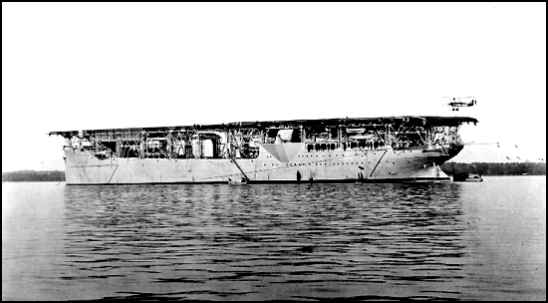
 |
|
circa 1922 Photo courtesy of the U. S. Naval Historical Center |
|
where naval air power first took flight |
|
The Associated Press NEWPORT NEWS -- A recently dedicated state historical marker commemorates Aviation Field Yorktown, where men in wood-and-fabric biplane's gave birth to naval airpower. The airfield existed for just a few years, more than eight decades ago, but it was there that Navy fliers first learned the skills of naval air combat -- and played a part in the history of the Navy's first aircraft carrier. The Yorktown flying field was the first naval air station in the mid-Atlantic region, established in 1919,. There, aviators were trained in bombing, gunnery and torpedo operations. Leo Forrest related at the unveiling ceremony. Forrest, a mechanical engineer at the Naval Weapons Station, has researched the history of the old flying field. The field was on a bluff above the York River near Felgates Creek, within what was then the Navy Mine Depot and now is the Yorktown Naval Weapons Station. (While the field was in York County, the marker sits just inside the Newport News city Line.) The Yorktown fliers made history in June 1921, when they joined other Navy planes taking off from Norfolk that bombed and sank a former German submarine captured during World War I. |
"For the first time it was to be demonstrated that bombs could be used to sink a vessel," Forrest said.
"This test, he said, preceded the better remembered bombing of surface ships by Gen Billy Mitchell's
planes from langley Field later
that year. Yorktown aviators also conducted the first trests of a high-altitude bombsight, which eventually developed into the celebrated Norden bombsight of World War II. The next year, the service found itself in need of an airfield near a deeop-water channel to support testing of its first aircraft carrie; the USS Langley, CV-1. Aviation Field Yorktown filled the bill. The first experimental flight off the deck of a ship had taken place back in 1910, from a platform erected on the cruiser USS Birmingham in Hampton Roads, but the Langley was the Navy's first bone fide aircraft carrier. "It just had a straight deck, no island." says Norm Crabill, a Newport News aerospace consultant with VIGYAN Inc. who was instrumental in getting the historical marker approved. Crabill chairs the marker committee of the Virginia Aeronautical Historical Society. On Oct. 17, 1922, as the Langley lay anchored in the York River, Lt. V.S. Griffin's Vought VE-7SF |
biplane took off from its deck, the first takeoff from a Navy aircraft carrier. Griffin is believed to have flown the plane back to
Norfolk, where it had been loaded onto the Langley, Forrest said.
The first aircraft carrier landing took place nine days later, when Lt. Cmdr. Godfrey Chevalier landed
his Aeromarine plane on the Langley as it was under way off Cape Henry. The Yorktown field wasn't done making history. In 1925, it was the destination for what may have been the first overland commercial passenger flight. Igor Sikorsky, the famed aircraft inventor, built a twin-engine biplane airliner and flew passengers to it from Roosevelt Field on Long Island, N.Y., to Washington and then on to Yorktown. The field still had a control tower at least until the 1980's. In October 1981, President Ronald Reagan landed in a helicopter there when he attended the Yorktown Victory Bicentennial celebration. The control tower is now gone, Crabill says. Ironically, the USS Langley itself became the victim of air power at sea. Converted to a seaplane tendetr in the 1930's, it was deployed in the Pacific in World War II when, in February 1942, it was bombed by Japanese aircraft. The crippled ship was abandoned and sunk. |
|
Back 

|